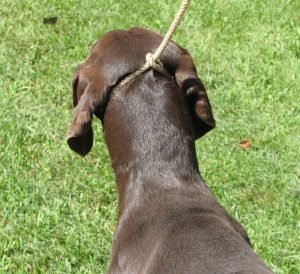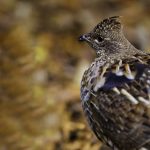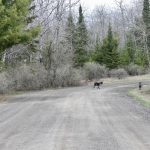Training the Hard Dog
by Bob and Jody Iler
What do we mean by training the “hard” dog?
Some other words to describe this type of pointing dog are bold, tough, independent, stubborn, or headstrong. This rambunctious pup will require training that will instill needed control without diminishing pup’s special brand of zest and enthusiasm. This is a real commitment; it’s often easier for an owner to let a pup have its way, and later complain that the pup was “just too much to handle!”
As trainers, we tend to gravitate toward the bold, sound pups in a litter, as they are usually outgoing in the field and eager for new experiences. On the other hand, they can be a handful as they mature. Without proper development that fosters their abilities while laying a foundation of control, they can quickly become “outlaws.”
Unlike his “softer” siblings, the bold pup will begin his obedience training at an earlier age – learning to heel, to whoa, and most importantly, to come (we use the here command for come). With bold pups, we’ll start this training by at least five months old.
For the heel and whoa commands, we use our special lead patterned after the one developed by Delmar Smith. A training collar and lead in one, it is extremely effective for big, bold pups with a mind of their own, and for older pups that have developed bad habits. Be sure to use the leather washer on the Delmar lead so that the pup can’t back out of it while training.
The lead is slipped over pup’s head, high under the throat, and lightly snubbed up behind the ears. It is held upright over the dog and easily keeps him in the heel position as you walk along, lightly applying a gentle, up and down “pumping” motion. When the dog is walking in place at your side, he will feel no pressure.
To introduce and teach the whoa command, we’ll slow to a stop and keep the pressure on the lead as we quietly give the whoa command. Soon the dog will learn to stop and stand still as we stop during the heeling process. If pup wants to sit, we’ll gently place our hand beneath his flank to keep him from doing so, as we command whoa. If the bold pup continues to sit, we fashion a half-hitch with the lead to keep him from doing so.
As pup learns the basic commands of heel and whoa, he’s also learning to pay attention to us, to walk at our side, and to stop when we do, and obey the whoa command. He is learning not to charge out on his own without a backward glance when we put the training lead on. In these sessions, we’ve been setting the stage for new lessons, where we’ll let him get farther away from us in a large yard area, and later, the field.
For this new training, we use a 15-20 foot checkcord attached to a slip training collar, which enables us to teach our pup to come when called, and also to quarter in the field. Just a reminder: The slip collar is used for training only and should never be left on your pup!
Start in a large yard area with pup on the long checkcord and walk about, letting him have his head. As he ranges out and reaches the end of the checkcord, give a quick pop as you command come or here! Insist that your pup come all the way back to you. Back up, get excited, slap your thigh, show him a treat – do whatever it takes to get his attention and keep him coming. Every time you give the command to come, he should feel the pop on his neck at the same time. Make sure you release the pop as soon as you give the command. You want him to come happily and willingly!
Once your pup is running in to you at the come command on a regular basis, it’s time to take this lesson to the field. Here, it may seem at first as though the two of you haven’t been training at all! Pup will be so excited by the sights and scents in the field that he may ignore you completely. Let him range out on the checkcord and explore. When he hits the end of the checkcord, pop the checkcord and give the come command, and repeat the exercise just as you’ve done in the yard.
When teaching the come command in the yard and field, don’t overdo. Consistent, positive sessions that last for 10 or 15 minutes are plenty at this stage. Remember, bold or not, he’s still a pup! Life must be fun while he’s learning this control business!
While he’s learning to be your partner and to pay attention to you, it’s also important to introduce this headstrong fellow to birds right along with the yard work. Before we do this, however, we want to acquaint our pup with quartering in the field. Quartering is simply teaching your pup to work in a zig zag pattern as you move forward across the field. Each time you change direction, you’ll pop the checkcord so pup notices and follows suit. This is another way of instilling control in the pup and reminding him to pay attention to you.
Now you can plant some birds in the field and let pup scent and find the birds. If he points, fine, but our main goal here is to get him excited about birds. As with softer pups, we’ll also let this adventuresome guy chase a few of those birds in the beginning to reinforce his natural enthusiasm and let him have fun. Then we’ll go back to using the checkcord to restrain him when the bird flushes and flies away.
 With bold pups that are bird crazy, we follow our regular program of gun development, reading our pup as we go through each step of the process to make sure that he’s paying no attention to the noise and remains focused on the birds. Generally, these pups will have few problems with gun development, but the “ounce of prevention” is always the smart course to follow.
With bold pups that are bird crazy, we follow our regular program of gun development, reading our pup as we go through each step of the process to make sure that he’s paying no attention to the noise and remains focused on the birds. Generally, these pups will have few problems with gun development, but the “ounce of prevention” is always the smart course to follow.
Ready to heel with the training lead.It often seems as though our “hard-headed” pups can take more pressure in their development, but we want to emphasize that it’s crucial to read every response that your bold pup gives as you train him. Never assume that you can’t harm him or set him back in his training by demanding too much or putting too much pressure on him. Patience, time and control work are the keys to developing a fine, bold pointing dog pup.
When our hard-headed pup has finished his started dog program, he’s ready for his first season of hunting. If we have trained the pup for a client, we show pup’s owner what to do by having regular yard work sessions, and practicing and maintaining control in the field. To establish and continue the bond between them, it’s important that in his first season, this pup be hunted alone or with a trained dog only, so as not to undo his control training.
If you have a hard-headed pointing dog that is older, don’t despair! Things can often be improved by going back to the basics. Yard work, control work in the field, and consistent use of training aids can undo some bad habits and teach the dog to pay attention to you, his hunting partner.
Finally, what about the e-collar in training this type of dog?
We work hard to help our “tough” guy learn and understand what we want of him – by laying a foundation of groundwork, consistent training, and control. During his first season, as pup matures in so many crucial areas of his development – we leave the electronic collar completely out of the equation. If, however, problems surface later, the e-collar can be an effective training tool to reinforce what has already been taught. We don’t recommend its use to the amateur trainer and suggest getting a professional’s help.
Training the “hard-headed” dog can be a daunting challenge for the novice pointing dog owner, but the rewards are often spectacular – joy, pride, and a sense of accomplishment that justifies all the hard work you and your bold partner have done!
Pointing Dog Pointers features monthly training tips by Bob and Jody Iler, who own Green Valley Kennels in Dubuque, Iowa. Bob and Jody have trained pointing dogs for over 35 years and have written many articles for The Pointing Dog Journal.






